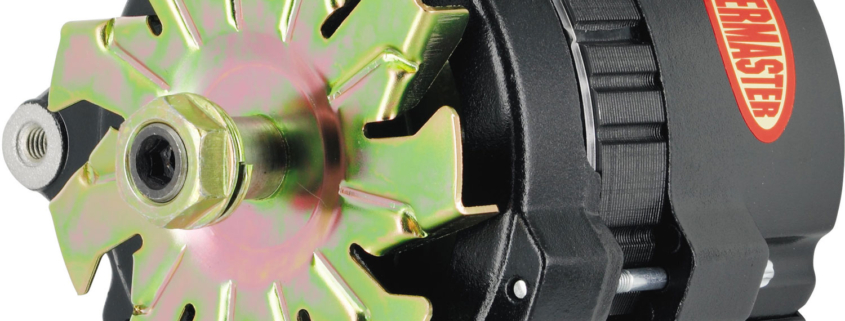3-Wire Alternator
Here’s a quick blog post showing you how to wire a 3-Wire Alternator with our Infinitybox system. When guys are updating their electrical systems in their cars, they have lots of choices. One of those choices is between a 1-wire and 3-wire alternator. Most cars originally came with a 3-wire alternator.
As its name implies, the 3-wire alternator has three electrical connections to it. The first is the large lug that connects to the battery. This is the main current feed that charges the battery and powers the car when the engine is running. There are two smaller terminals, usually spade terminals on the top of the alternator. One of these is the sense terminal. You connect the output of the alternator back to this terminal so that it can sense and regulate the output voltage. The other terminal is the exciter. This is what excites the field of the alternator.
The following diagram shows the wiring for a typical 3-wire alternator connected to our Infinitybox system. Please refer to the manual and wiring diagram that came with your alternator for more specific details.
Here are the important parts of this diagram.
First, you need to connect the alternator directly to the positive terminal on the battery. This is how the battery gets charged when the engine is running. It is very important to make sure that nothing interrupts this feed to the battery. You should never install a disconnect switch between the alternator and the battery. If the alternator is ever disconnected from the battery when it is charging, you get something called a load dump and that’s a bad thing. Read this blog post for more information.
Next, you must wire the sense terminal. Check the manual that came with your alternator. Usually, this is a direct connection from the alternator output back to the sense terminal.
Lastly, you need to wire the exciter. This is where the charge light gets connected into the system. One end of the charge light connects to the output of the POWERCELL that is powering the ignition in the car. The other end of the light connects to the exciter terminal on the alternator. You also need to install a diode on the POWERCELL side of the light. This diode blocks current from feeding back into the ignition system. Without this diode, the engine will continue to run even though you have turned off the ignition output. The orientation of this diode is critical, check the diagram for more details.
Here’s how the charge light works. When the ignition is on, there is 12-volts on the POWERCELL side of the light. Without the engine running and the alternator turning, there is no voltage on the alternator side. Current flows through the light and turns it on.
When the engine is running, you have battery voltage on the POWERCELL side of the light. Since the alternator is turning, you also have battery voltage on the exciter wire from the alternator. There is no net voltage drop across the bulb so it does not light.
If your alternator stops generating current when the ignition is on and the engine is running, you back to the first scenario. There is voltage on the POWERCELL side but no voltage on the alternator side. This makes the bulb light and warns you that you have a problem with your alternator.
Please note that this is intended to work with an incandescent light bulb for the charge light. You can do this with LED’s but you must have a bypass resistor so that the exciter will work correctly. See the instructions that came with your 3-wire alternator.
You can download a PDF of this wiring diagram by clicking this link.
Reach out to our technical support group with any questions or comments about this wiring diagram.



 Copyright Infinitybox, LLC 2021. All Rights Reserved.
Copyright Infinitybox, LLC 2021. All Rights Reserved. 
Leave a Reply
Want to join the discussion?Feel free to contribute!